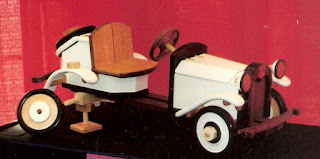
You may not know about Chincoteague...
but, it's a place near and dear to our hearts. If you are trying to avoid the mass hysteria of "Black Friday", I recommend that you consider a trip to Chincoteague, Virginia instead.
Years ago, when we started to go to "carving" shows, many of our friends and colleagues, in particular, the late great Lee Scheely, told us: "You've got to go to Chincoteague!". The way it was put made the show a bit intimidating. We didn't know if we could even get in, especially where our subject is boats, rather than birds. There is, however, a good deal of carving that goes into our work and so we started "doing Chincoteague". It may have been one of the best things we've done.
There are actually three of the Chincoteague carving shows each year: Thanksgiving, Easter and Labor Day. We've never been able to do Labor Day for unrelated reasons. We've discussed the Easter show on our Facebook page. This weekend (Friday & Saturday Nov. 25th & 26th) is the Thanksgiving show. It's also a Christmas show.
Let me tell you about these shows. They are held at the Chincoteague Combined School in its gymnasium. No huge signs out front. You might think that you're looking at a Holiday Bazaar or other Craft Fair when you only look at the outside of the building. A school with a lot of vans and trailers parked outside. Sounds like a bunch of amateurs???
When I first came to these shows, I was blown away. The exhibitors represented the Master's Masters of carving, many that I knew from Havre de Grace and The Waterfowl Festival and other great nationally recognized shows. Among them were Bill Veasey and Shannon Dimmig, Vince Ciesielski (I probably spelled his name incorrectly), Bill Cowen, Jennifer Daisey, Russell Fish, Walt Schmitz, Bill Hickson, Rocky Detwiler and scores of other truly great carvers. The painters and sculptors were no less amazing. Other artists, such as Donnie Thornton and Don & Donna Drew really rounded the shows out nicely. There is no room to mention many of them, no less to describe their work.
What was also amazing was to find such a low key atmosphere, where you didn't just have the opportunity to see some amazing art and artistry, but the opportunity to spend time talking with the artists and getting to know them. Over the years, we've made a lot of friends and we've learned a lot of things from being in the Chincoteague carving shows. Unfortunately, we've lost more than a few of those friends over those years, such as Lee, Don Repsher and some others who we came to expect to see when we arrived and now really miss. We were lucky to have the opportunities to learn from them and to be able to call such great people our friends.
These shows have changed over the years. Everyone used to know about them - they were legendary. Word of mouth has been overcome by electronic media and low budget shows can't buy the advertising that the large retailers can. The Deborah Waterfowl Show and Auction is a truly great show with truly great carvers and artists of many kinds. It's an honest display of high quality things, in some cases among the best in the world of those things. They are reasonably priced and made with precision and care. If you are looking for gifts, you will be amazed at what awaits you.
As you consider the idea of patronizing small businesses, I recommend that you consider this show, full of hard-working people, who, although they may not be immediately recognized as such, are small business owners. Proceeds from the show benefit the Deborah Heart & Lung Center in Brown's Mills, NJ. As with the eggs that we carve for the silent auction at the Easter show, we apply our talents to wooden balls such as the one below. Come to the live auction on Saturday night to get your hands on some very special things...
The show is only a small reason to come to the island of Chincoteague. It's a beautiful town with shops, restaurants, hotels, B&Bs and beautiful views. The Wildlife Refuge opens up miles of road that are only open for Thanksgiving weekend. You can see the famous ponies (don't tell me that you've never heard of "Misty of Chincoteague"), Snow Geese, deer, beaches and... I've told you enough.

















